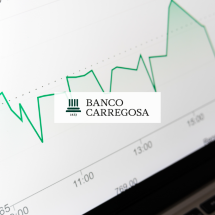- The Bank
- People
- All Services
- Private Banking
- Savings and Investment
- GoBulling Platforms
- Institutional and Corporate
- Insights
- Login My.BancoCarregosa
- Contacts
Enter your Username to gain access to your Bank. Complete your authentication on the next screen.
If you are not yet a client, open your account here or contact us for more information
Volatility: what it is and how to deal with it


Feared by some, exploited by others. Find out what volatility is all about and how to take advantage of the opportunities it offers.
For any investor, especially those in emerging markets and innovative sectors, understanding how to deal with market volatility is essential. Find out what volatility is, what factors determine it and how to manage it.
What is volatility in investments?
Volatility measures fluctuations in the value of a particular financial asset over a period of time. Investors use volatility to assess the risk associated with a particular investment. While more volatile assets can fluctuate significantly in value over short periods of time, resulting in substantial gains or losses, less volatile assets tend to have smoother or smaller price fluctuations.
Volatility, however, is not only an indication of a sustainable long-term trend, only of the intensity of the fluctuations. To manage their risk and more informed decisions, investors can use a variety of strategies based on the state of market volatility.
How does volatility work?
There are a number of factors that can have an impact on financial market volatility, which are often interrelated and interact with each other. The main factors include:
1. Geopolitical, economic and financial factors
Unexpected economic and geopolitical events, financial crises and monetary policy decisions can have a significant impact on volatility. For instance, inflation, unemployment, and announcements made by central banks on interest rates or other issues may trigger substantial movements in financial markets.
2. Investor behaviour
Volatility is not only an objective response to economic conditions, but can also be influenced by the emotions and perceptions of market participants. For example, in times of crisis or euphoria, investors can make impulsive decisions that increase volatility – such as massive selling or excessive buying, creating the bandwagon effect.
3. Corporate performance
The performance of individual companies, sectors or even economies can affect investor confidence and market momentum. Better than expected results can lead to sharp rises in share prices, while underperformance can lead to sharp falls. Volatility can also be influenced by other factors, such as the development of innovative products or changes in management and leadership.
"VIX Index”, the volatility indicator
The VIX index is an indicator that measures the expected 30-day volatility of the US stock market. It is also known as the "Fear Index" because it tends to rise during periods of market stress or uncertainty.
This index is calculated using call and put options on the S&P 500 Index. The calculation is based on a complex formula that takes into account options of different maturities and at different prices.
The interpretation of the VIX Index is simple: the higher the index, the higher the market's volatility expectations, which indicates a more risky and uncertain environment. On the other hand, a lower VIX indicates lower volatility expectations and therefore a calmer market environment.
However, while the VIX index is an important and widely used indicator, it is not a predictor of the specific direction of market movements, only the amplitude of expected volatility. Investors are therefore advised to consider a combination of indicators and analyses when making their investment decisions.
How can volatility be managed in practice?
Managing volatility involves the implementation of strategies and best practices to protect investments and reduce the risks associated with sudden movements in financial markets. Here are some of the steps to consider.
Portfolio diversification
Spreading investments across different asset classes, such as equities, bonds, real estate and others, helps to reduce the risk of losses being concentrated in any one area. If one asset class experiences a more difficult period, others may perform better, balancing the overall portfolio.
Definition of the objectives and the risk profile
This is an important step before making any investment decision. If the investor is more comfortable with a moderate level of risk, the asset allocation should reflect this, avoiding over-exposure to more volatile assets. In other words, your financial goals, investment horizon and willingness to accept volatility should be reflected in your asset allocation.
Using stop-loss orders
Stop Loss Orders can be an important way to limit losses on certain types of positions. These orders will close a position when the price reaches a pre-determined level, helping to limit losses in times of volatility.
For example, some investors set their stop-loss at a certain percentage below the buying price. They can also opt for dynamic stop-losses, which take into account changing conditions and help to adjust the stop order to market fluctuations.
Using "price alerts”
You can use price alerts to help you place stop-loss or stop-profit orders ("money management”) on winning positions, which is just as important, if not more so, than selecting the asset and entry timing, especially when market volatility increases.
Managing volatility with Banco Carregosa
Volatility management should always be tailored to an investor’s objectives, time horizon and risk tolerance. There is no one-size-fits-all approach for investors, so it is essential to seek specialist professional advice. You can use ETFs to manage risk in the very short term or options (e.g. high volatility tends to increase the premiums on your call and put contracts. You can count on the Banco Carregosa team to assess your individual situation, define your objectives and develop personalised investment strategies.



















